engine TOYOTA AYGO 2014 (in English) User Guide
[x] Cancel search | Manufacturer: TOYOTA, Model Year: 2014, Model line: AYGO, Model: TOYOTA AYGO 2014Pages: 372, PDF Size: 14.28 MB
Page 91 of 372
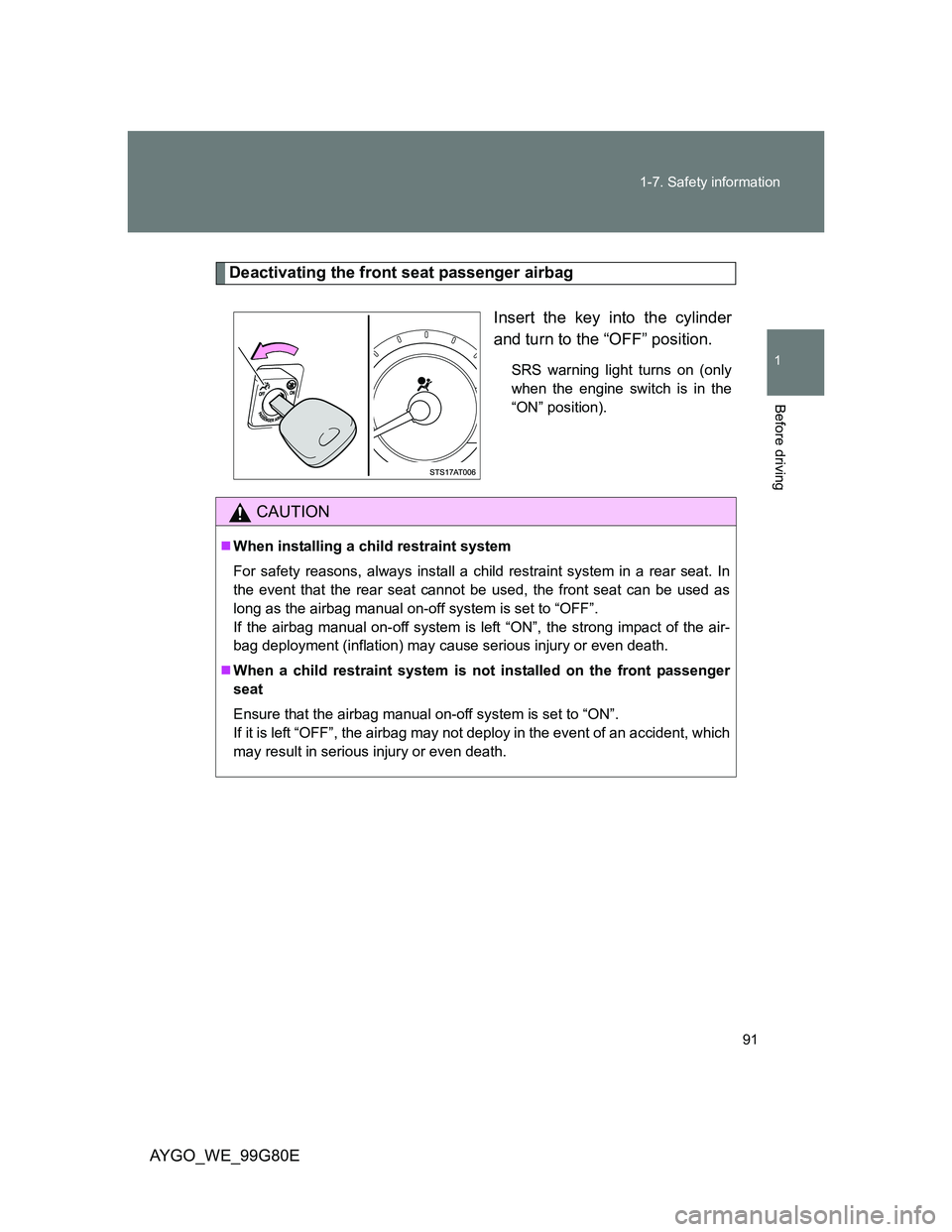
91 1-7. Safety information
1
Before driving
AYGO_WE_99G80E
Deactivating the front seat passenger airbag
Insert the key into the cylinder
and turn to the “OFF” position.
SRS warning light turns on (only
when the engine switch is in the
“ON” position).
CAUTION
When installing a child restraint system
For safety reasons, always install a child restraint system in a rear seat. In
the event that the rear seat cannot be used, the front seat can be used as
long as the airbag manual on-off system is set to “OFF”.
If the airbag manual on-off system is left “ON”, the strong impact of the air-
bag deployment (inflation) may cause serious injury or even death.
When a child restraint system is not installed on the front passenger
seat
Ensure that the airbag manual on-off system is set to “ON”.
If it is left “OFF”, the airbag may not deploy in the event of an accident, which
may result in serious injury or even death.
Page 113 of 372
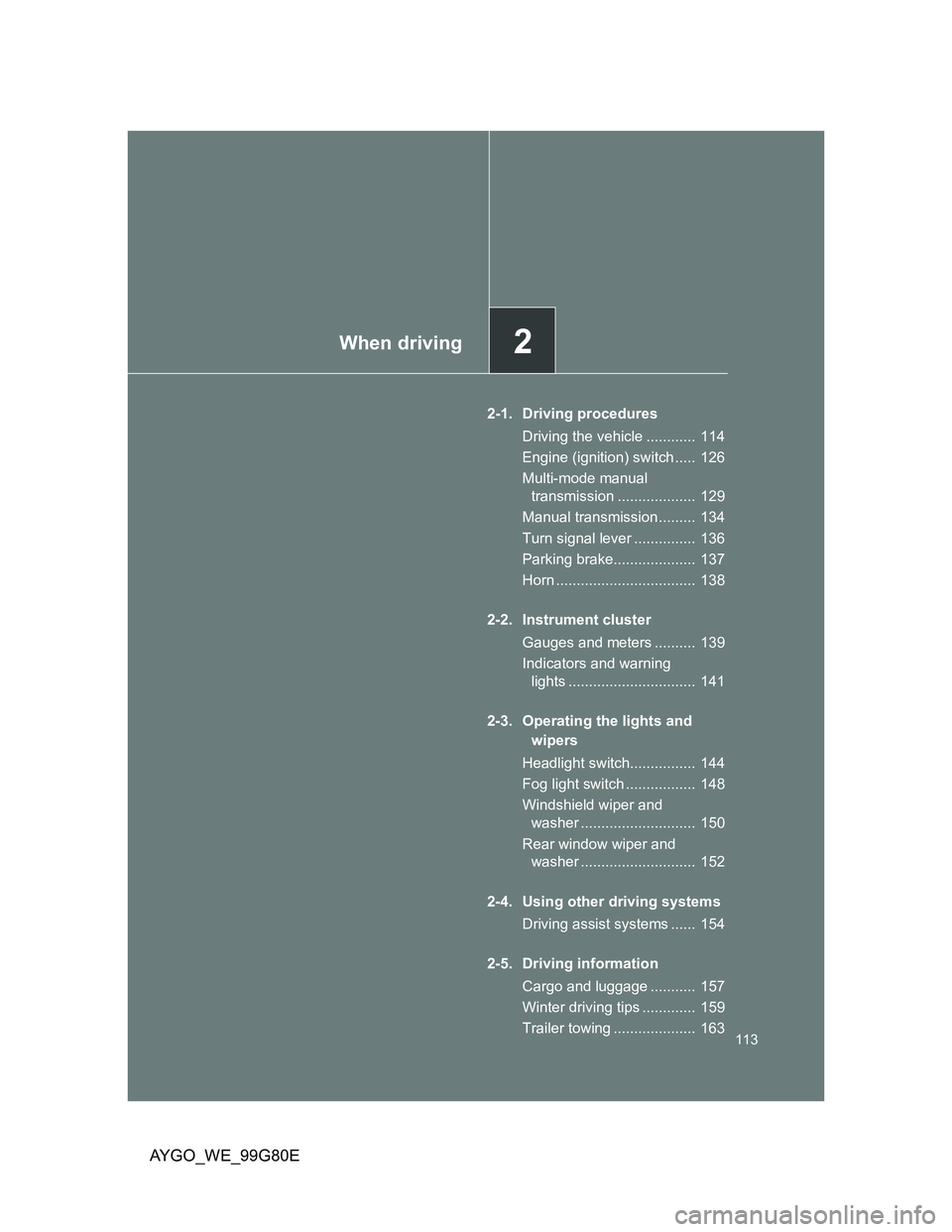
2When driving
113
AYGO_WE_99G80E
2-1. Driving procedures
Driving the vehicle ............ 114
Engine (ignition) switch ..... 126
Multi-mode manual
transmission ................... 129
Manual transmission ......... 134
Turn signal lever ............... 136
Parking brake.................... 137
Horn .................................. 138
2-2. Instrument cluster
Gauges and meters .......... 139
Indicators and warning
lights ............................... 141
2-3. Operating the lights and
wipers
Headlight switch................ 144
Fog light switch ................. 148
Windshield wiper and
washer ............................ 150
Rear window wiper and
washer ............................ 152
2-4. Using other driving systems
Driving assist systems ...... 154
2-5. Driving information
Cargo and luggage ........... 157
Winter driving tips ............. 159
Trailer towing .................... 163
Page 114 of 372

114
AYGO_WE_99G80E
2-1. Driving procedures
Driving the vehicle
The following procedures should be observed to ensure safe driv-
ing:
Starting the engine
P. 126
Driving
Vehicles with a multi-mode manual transmission
With the brake pedal depressed, shift the shift lever to E or
M. (P. 129)
When shifting the shift lever to E: Make sure that the display of the
gear position indicator shows E.
When shifting the shift lever to M: Make sure that the display of
the gear position indicator shows 1.
Release the parking brake. (P. 137)
Gradually release the brake pedal and gently depress the
accelerator pedal to accelerate the vehicle.
Vehicles with a manual transmission
While depressing the clutch pedal, shift the shift lever to 1.
(P. 134)
Release the parking brake. (P. 137)
Gradually release the clutch pedal. At the same time, gently
depress the accelerator pedal to accelerate the vehicle.
Page 115 of 372
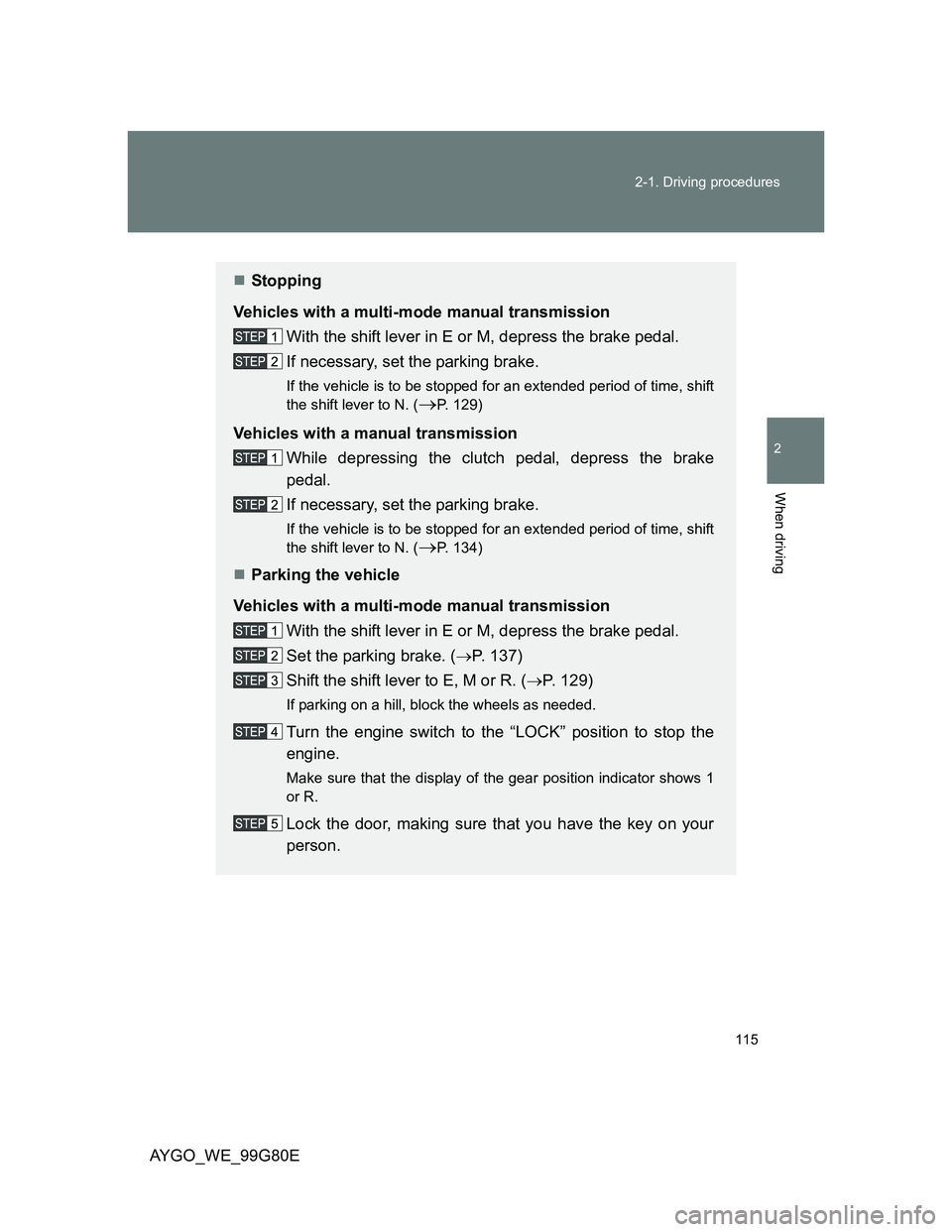
115 2-1. Driving procedures
2
When driving
AYGO_WE_99G80E
Stopping
Vehicles with a multi-mode manual transmission
With the shift lever in E or M, depress the brake pedal.
If necessary, set the parking brake.
If the vehicle is to be stopped for an extended period of time, shift
the shift lever to N. (
P. 129)
Vehicles with a manual transmission
While depressing the clutch pedal, depress the brake
pedal.
If necessary, set the parking brake.
If the vehicle is to be stopped for an extended period of time, shift
the shift lever to N. (
P. 134)
Parking the vehicle
Vehicles with a multi-mode manual transmission
With the shift lever in E or M, depress the brake pedal.
Set the parking brake. (P. 137)
Shift the shift lever to E, M or R. (P. 129)
If parking on a hill, block the wheels as needed.
Turn the engine switch to the “LOCK” position to stop the
engine.
Make sure that the display of the gear position indicator shows 1
or R.
Lock the door, making sure that you have the key on your
person.
Page 116 of 372
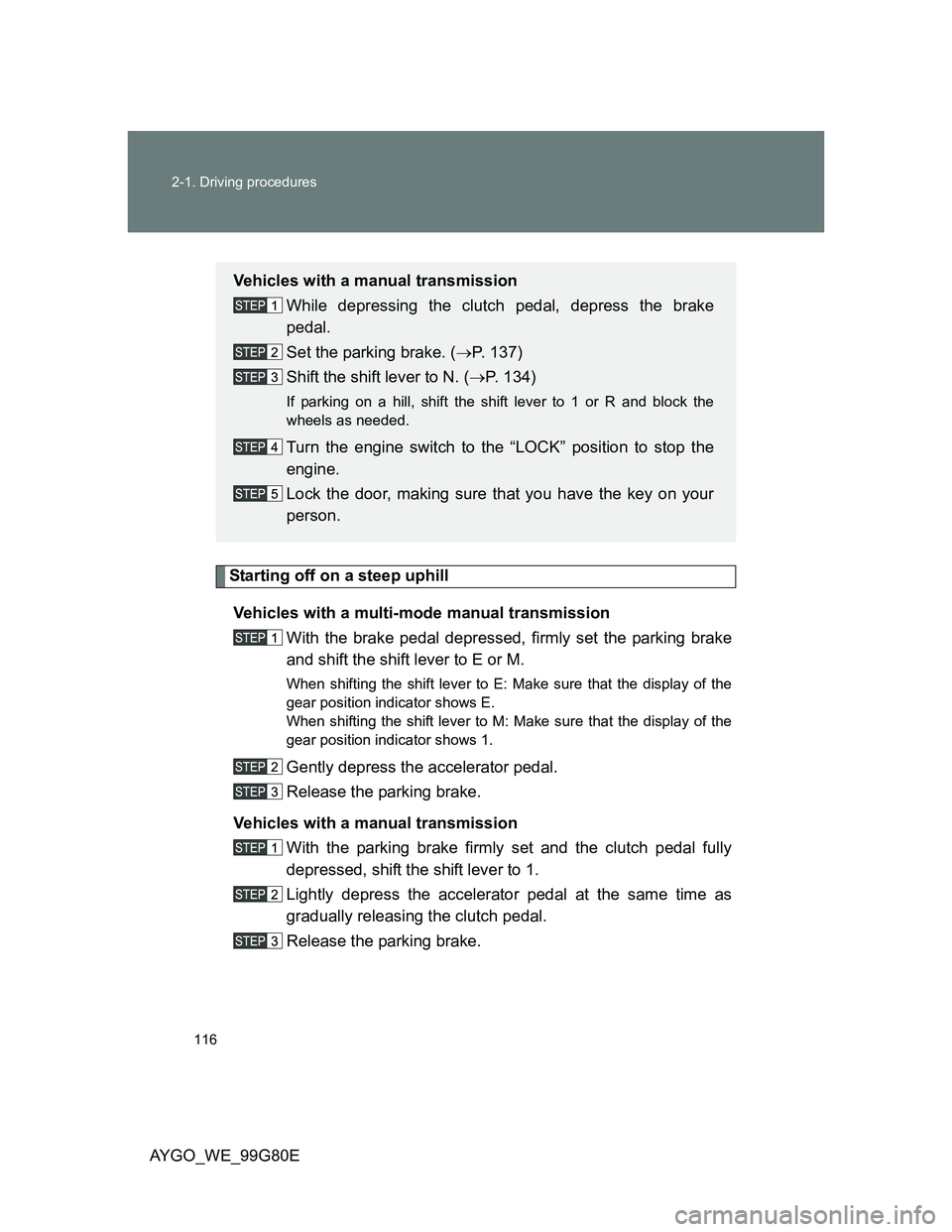
116 2-1. Driving procedures
AYGO_WE_99G80E
Starting off on a steep uphill
Vehicles with a multi-mode manual transmission
With the brake pedal depressed, firmly set the parking brake
and shift the shift lever to E or M.
When shifting the shift lever to E: Make sure that the display of the
gear position indicator shows E.
When shifting the shift lever to M: Make sure that the display of the
gear position indicator shows 1.
Gently depress the accelerator pedal.
Release the parking brake.
Vehicles with a manual transmission
With the parking brake firmly set and the clutch pedal fully
depressed, shift the shift lever to 1.
Lightly depress the accelerator pedal at the same time as
gradually releasing the clutch pedal.
Release the parking brake.
Vehicles with a manual transmission
While depressing the clutch pedal, depress the brake
pedal.
Set the parking brake. (P. 137)
Shift the shift lever to N. (P. 134)
If parking on a hill, shift the shift lever to 1 or R and block the
wheels as needed.
Turn the engine switch to the “LOCK” position to stop the
engine.
Lock the door, making sure that you have the key on your
person.
Page 118 of 372
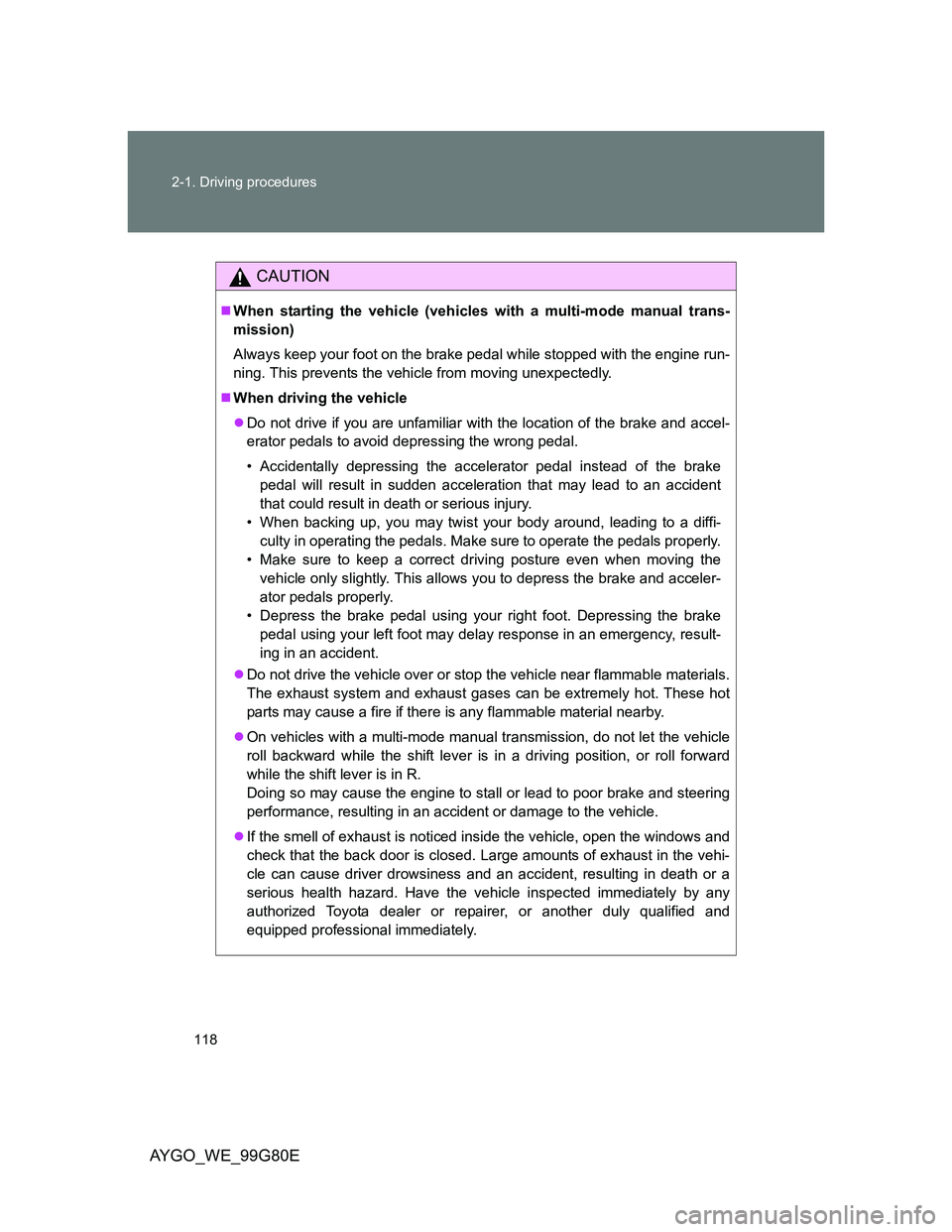
118 2-1. Driving procedures
AYGO_WE_99G80E
CAUTION
When starting the vehicle (vehicles with a multi-mode manual trans-
mission)
Always keep your foot on the brake pedal while stopped with the engine run-
ning. This prevents the vehicle from moving unexpectedly.
When driving the vehicle
Do not drive if you are unfamiliar with the location of the brake and accel-
erator pedals to avoid depressing the wrong pedal.
• Accidentally depressing the accelerator pedal instead of the brake
pedal will result in sudden acceleration that may lead to an accident
that could result in death or serious injury.
• When backing up, you may twist your body around, leading to a diffi-
culty in operating the pedals. Make sure to operate the pedals properly.
• Make sure to keep a correct driving posture even when moving the
vehicle only slightly. This allows you to depress the brake and acceler-
ator pedals properly.
• Depress the brake pedal using your right foot. Depressing the brake
pedal using your left foot may delay response in an emergency, result-
ing in an accident.
Do not drive the vehicle over or stop the vehicle near flammable materials.
The exhaust system and exhaust gases can be extremely hot. These hot
parts may cause a fire if there is any flammable material nearby.
On vehicles with a multi-mode manual transmission, do not let the vehicle
roll backward while the shift lever is in a driving position, or roll forward
while the shift lever is in R.
Doing so may cause the engine to stall or lead to poor brake and steering
performance, resulting in an accident or damage to the vehicle.
If the smell of exhaust is noticed inside the vehicle, open the windows and
check that the back door is closed. Large amounts of exhaust in the vehi-
cle can cause driver drowsiness and an accident, resulting in death or a
serious health hazard. Have the vehicle inspected immediately by any
authorized Toyota dealer or repairer, or another duly qualified and
equipped professional immediately.
Page 119 of 372
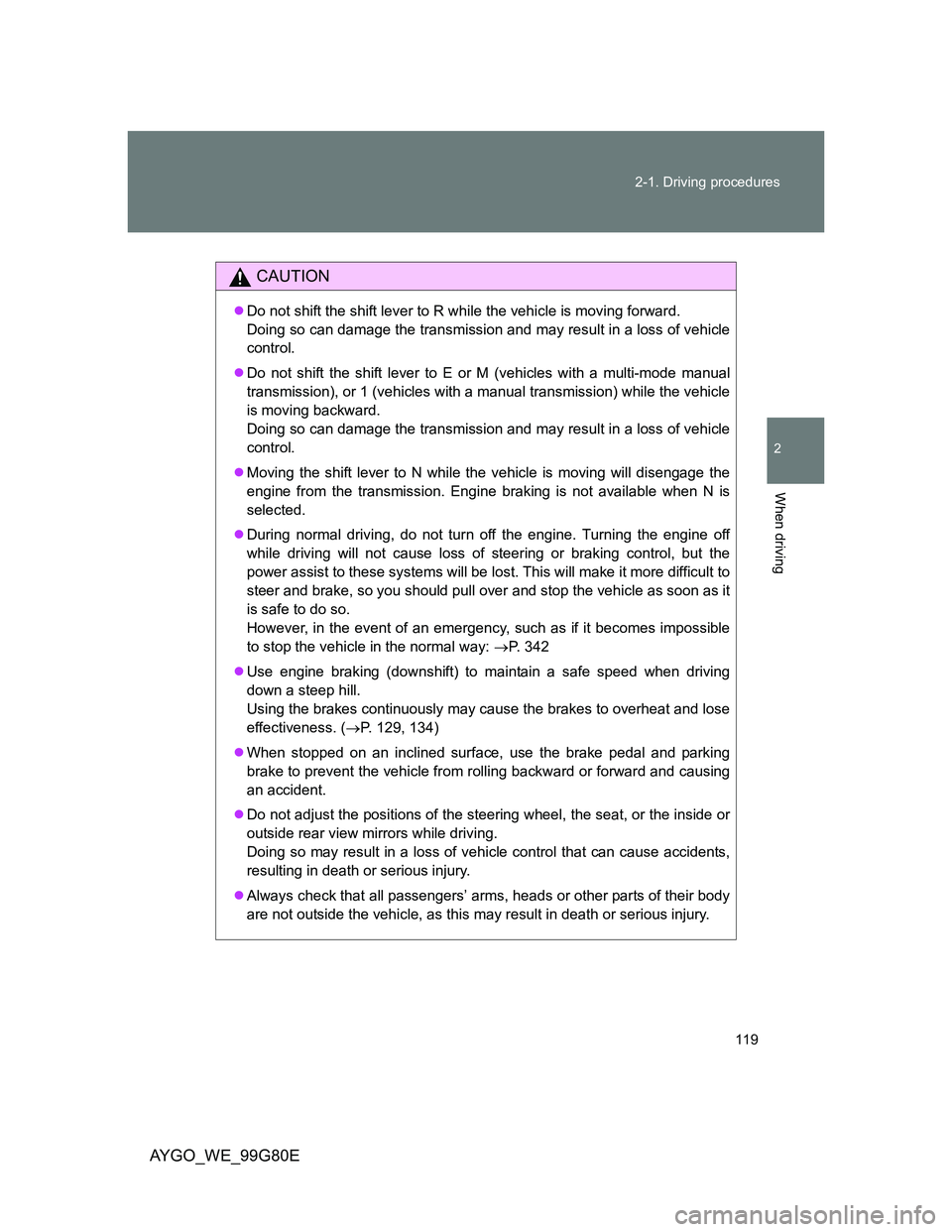
119 2-1. Driving procedures
2
When driving
AYGO_WE_99G80E
CAUTION
Do not shift the shift lever to R while the vehicle is moving forward.
Doing so can damage the transmission and may result in a loss of vehicle
control.
Do not shift the shift lever to E or M (vehicles with a multi-mode manual
transmission), or 1 (vehicles with a manual transmission) while the vehicle
is moving backward.
Doing so can damage the transmission and may result in a loss of vehicle
control.
Moving the shift lever to N while the vehicle is moving will disengage the
engine from the transmission. Engine braking is not available when N is
selected.
During normal driving, do not turn off the engine. Turning the engine off
while driving will not cause loss of steering or braking control, but the
power assist to these systems will be lost. This will make it more difficult to
steer and brake, so you should pull over and stop the vehicle as soon as it
is safe to do so.
However, in the event of an emergency, such as if it becomes impossible
to stop the vehicle in the normal way: P. 342
Use engine braking (downshift) to maintain a safe speed when driving
down a steep hill.
Using the brakes continuously may cause the brakes to overheat and lose
effectiveness. (P. 129, 134)
When stopped on an inclined surface, use the brake pedal and parking
brake to prevent the vehicle from rolling backward or forward and causing
an accident.
Do not adjust the positions of the steering wheel, the seat, or the inside or
outside rear view mirrors while driving.
Doing so may result in a loss of vehicle control that can cause accidents,
resulting in death or serious injury.
Always check that all passengers’ arms, heads or other parts of their body
are not outside the vehicle, as this may result in death or serious injury.
Page 120 of 372
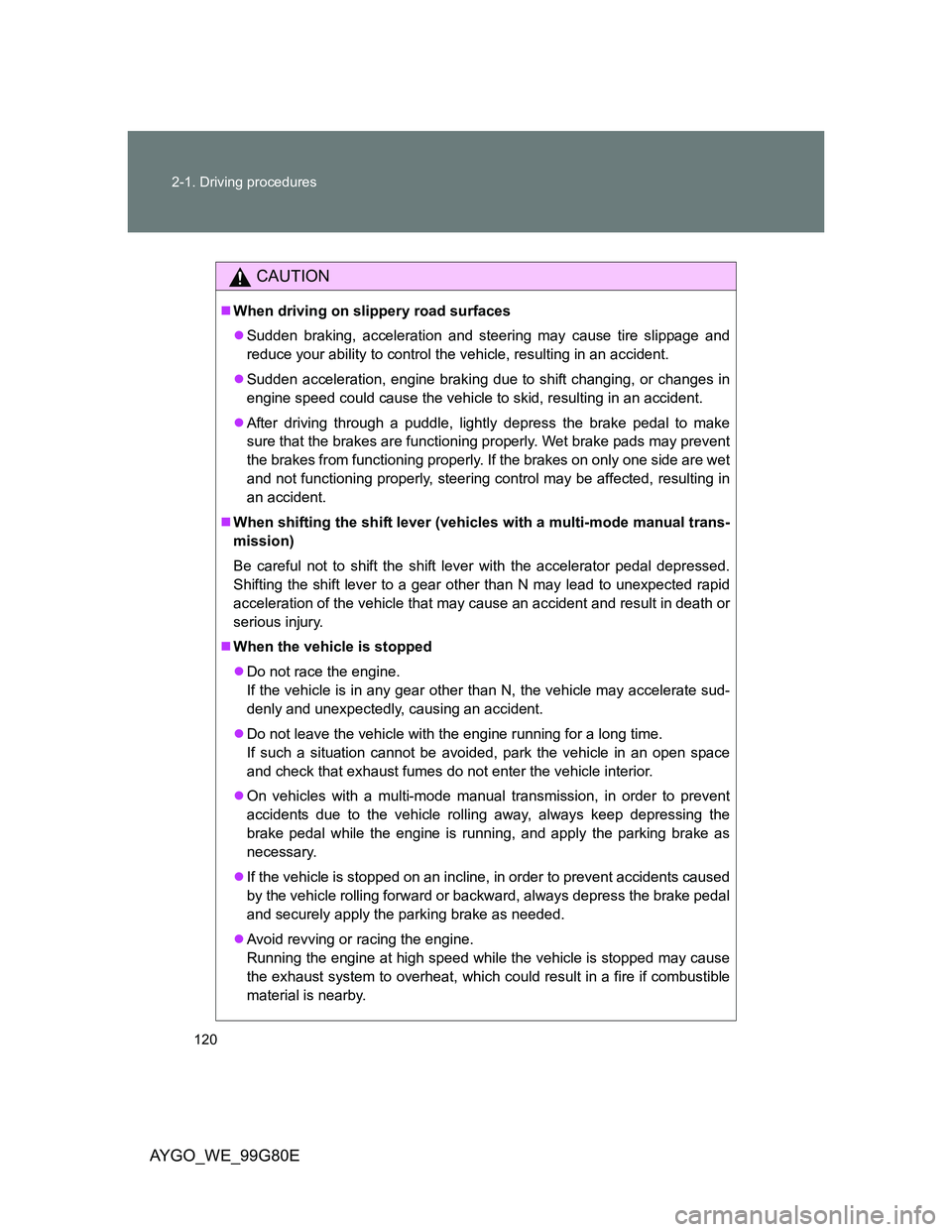
120 2-1. Driving procedures
AYGO_WE_99G80E
CAUTION
When driving on slippery road surfaces
Sudden braking, acceleration and steering may cause tire slippage and
reduce your ability to control the vehicle, resulting in an accident.
Sudden acceleration, engine braking due to shift changing, or changes in
engine speed could cause the vehicle to skid, resulting in an accident.
After driving through a puddle, lightly depress the brake pedal to make
sure that the brakes are functioning properly. Wet brake pads may prevent
the brakes from functioning properly. If the brakes on only one side are wet
and not functioning properly, steering control may be affected, resulting in
an accident.
When shifting the shift lever (vehicles with a multi-mode manual trans-
mission)
Be careful not to shift the shift lever with the accelerator pedal depressed.
Shifting the shift lever to a gear other than N may lead to unexpected rapid
acceleration of the vehicle that may cause an accident and result in death or
serious injury.
When the vehicle is stopped
Do not race the engine.
If the vehicle is in any gear other than N, the vehicle may accelerate sud-
denly and unexpectedly, causing an accident.
Do not leave the vehicle with the engine running for a long time.
If such a situation cannot be avoided, park the vehicle in an open space
and check that exhaust fumes do not enter the vehicle interior.
On vehicles with a multi-mode manual transmission, in order to prevent
accidents due to the vehicle rolling away, always keep depressing the
brake pedal while the engine is running, and apply the parking brake as
necessary.
If the vehicle is stopped on an incline, in order to prevent accidents caused
by the vehicle rolling forward or backward, always depress the brake pedal
and securely apply the parking brake as needed.
Avoid revving or racing the engine.
Running the engine at high speed while the vehicle is stopped may cause
the exhaust system to overheat, which could result in a fire if combustible
material is nearby.
Page 121 of 372
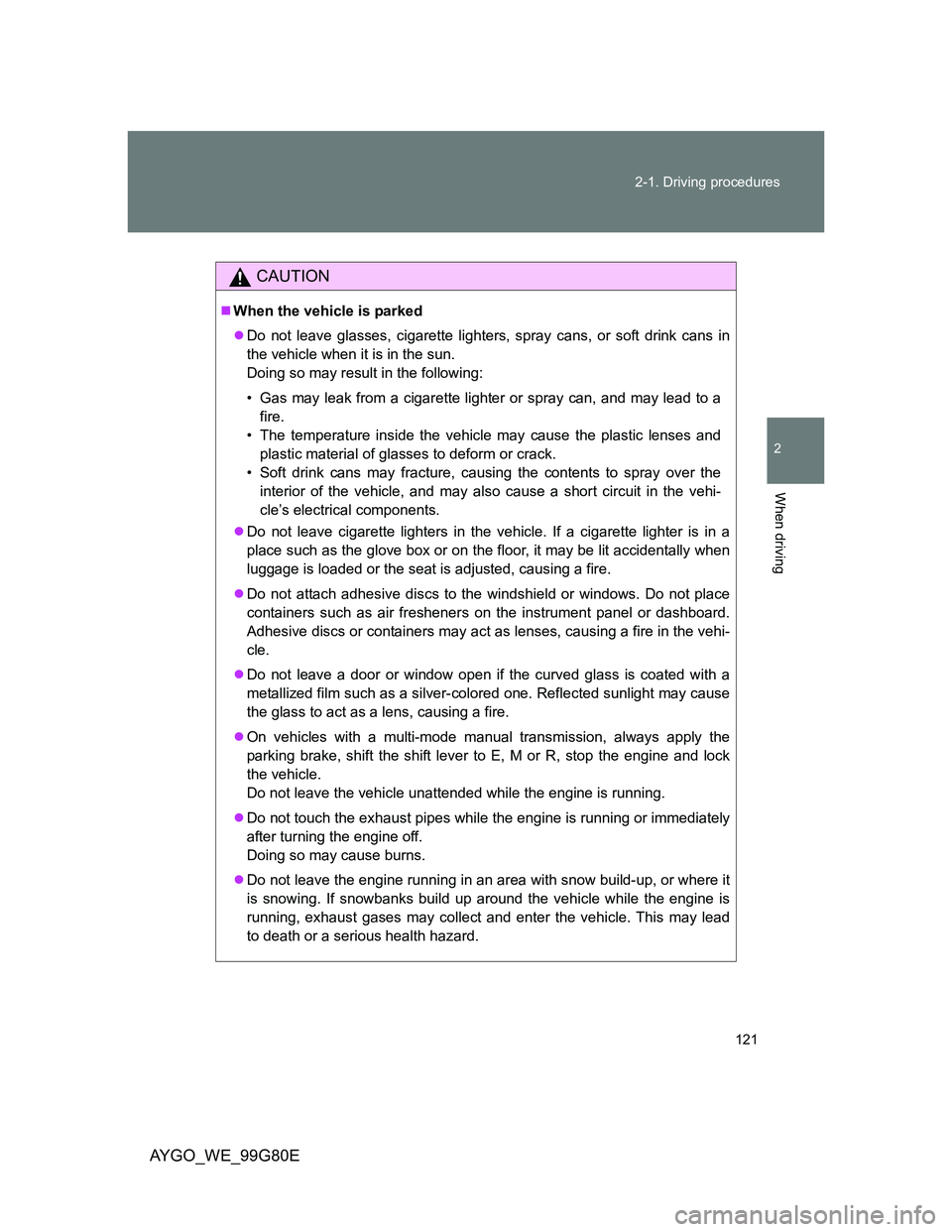
121 2-1. Driving procedures
2
When driving
AYGO_WE_99G80E
CAUTION
When the vehicle is parked
Do not leave glasses, cigarette lighters, spray cans, or soft drink cans in
the vehicle when it is in the sun.
Doing so may result in the following:
• Gas may leak from a cigarette lighter or spray can, and may lead to a
fire.
• The temperature inside the vehicle may cause the plastic lenses and
plastic material of glasses to deform or crack.
• Soft drink cans may fracture, causing the contents to spray over the
interior of the vehicle, and may also cause a short circuit in the vehi-
cle’s electrical components.
Do not leave cigarette lighters in the vehicle. If a cigarette lighter is in a
place such as the glove box or on the floor, it may be lit accidentally when
luggage is loaded or the seat is adjusted, causing a fire.
Do not attach adhesive discs to the windshield or windows. Do not place
containers such as air fresheners on the instrument panel or dashboard.
Adhesive discs or containers may act as lenses, causing a fire in the vehi-
cle.
Do not leave a door or window open if the curved glass is coated with a
metallized film such as a silver-colored one. Reflected sunlight may cause
the glass to act as a lens, causing a fire.
On vehicles with a multi-mode manual transmission, always apply the
parking brake, shift the shift lever to E, M or R, stop the engine and lock
the vehicle.
Do not leave the vehicle unattended while the engine is running.
Do not touch the exhaust pipes while the engine is running or immediately
after turning the engine off.
Doing so may cause burns.
Do not leave the engine running in an area with snow build-up, or where it
is snowing. If snowbanks build up around the vehicle while the engine is
running, exhaust gases may collect and enter the vehicle. This may lead
to death or a serious health hazard.
Page 122 of 372
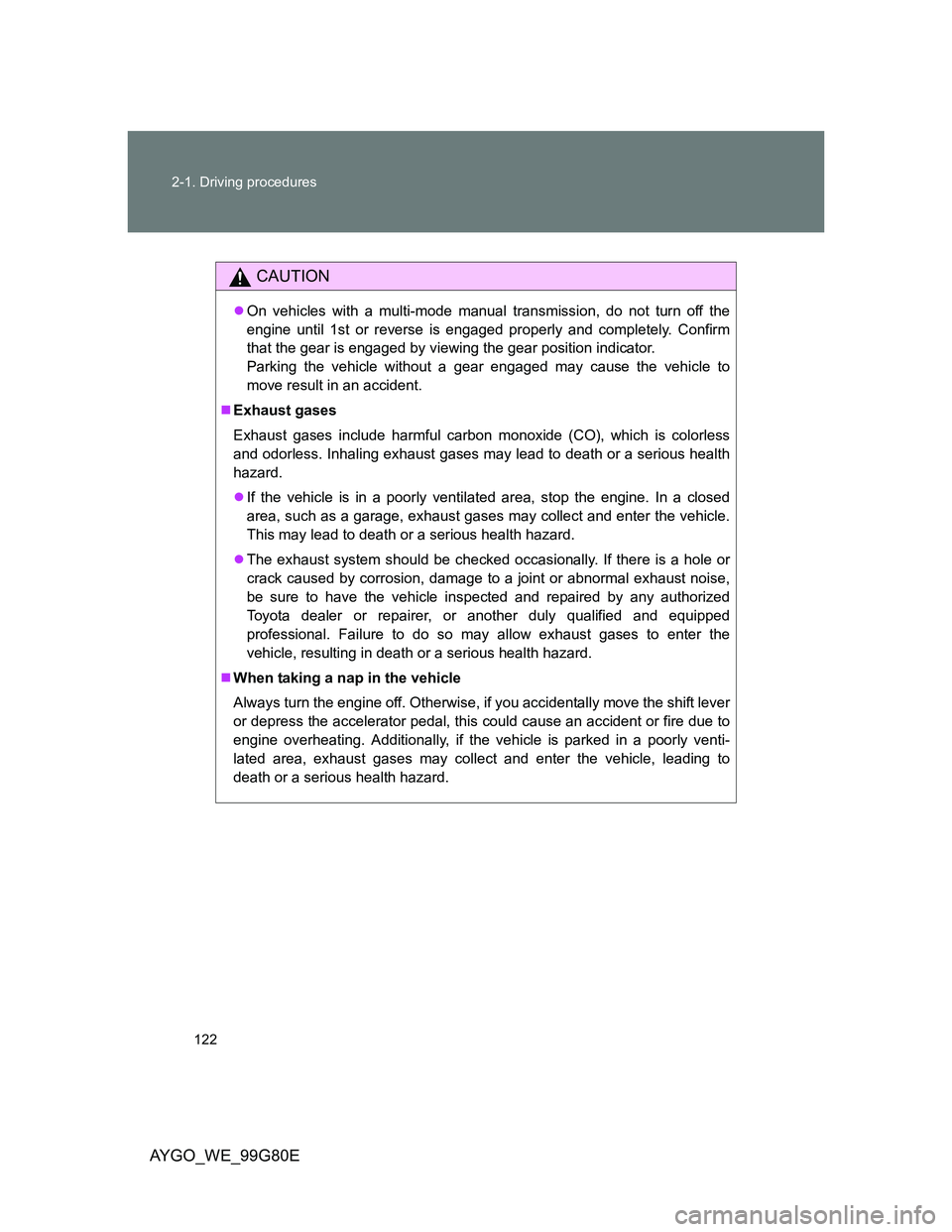
122 2-1. Driving procedures
AYGO_WE_99G80E
CAUTION
On vehicles with a multi-mode manual transmission, do not turn off the
engine until 1st or reverse is engaged properly and completely. Confirm
that the gear is engaged by viewing the gear position indicator.
Parking the vehicle without a gear engaged may cause the vehicle to
move result in an accident.
Exhaust gases
Exhaust gases include harmful carbon monoxide (CO), which is colorless
and odorless. Inhaling exhaust gases may lead to death or a serious health
hazard.
If the vehicle is in a poorly ventilated area, stop the engine. In a closed
area, such as a garage, exhaust gases may collect and enter the vehicle.
This may lead to death or a serious health hazard.
The exhaust system should be checked occasionally. If there is a hole or
crack caused by corrosion, damage to a joint or abnormal exhaust noise,
be sure to have the vehicle inspected and repaired by any authorized
Toyota dealer or repairer, or another duly qualified and equipped
professional. Failure to do so may allow exhaust gases to enter the
vehicle, resulting in death or a serious health hazard.
When taking a nap in the vehicle
Always turn the engine off. Otherwise, if you accidentally move the shift lever
or depress the accelerator pedal, this could cause an accident or fire due to
engine overheating. Additionally, if the vehicle is parked in a poorly venti-
lated area, exhaust gases may collect and enter the vehicle, leading to
death or a serious health hazard.